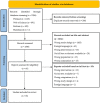Clinical Effectiveness of Dry Needling in Patients with Musculoskeletal Pain-An Umbrella Review
- PMID: 36769852
- PMCID: PMC9917679
- DOI: 10.3390/jcm12031205
Clinical Effectiveness of Dry Needling in Patients with Musculoskeletal Pain-An Umbrella Review
Abstract
The number of systematic reviews (SR) summarizing the literature regarding the clinical effects of Dry Needling (DN) has increased rapidly. Yet, rigorous evidence about the clinical effectiveness of this technique is still lacking. The aim of this umbrella review is to summarize the evidence about the clinical effects of trigger point DN on musculoskeletal disorders across all body regions. PubMed, Web of Science and Embase were searched to identify SRs examining the effect of DN (as a stand-alone intervention or combined with another treatment modality) compared to sham/no intervention or a physical therapy (PT) intervention with at least one clinical outcome in the domain of pain or physical functioning. Risk of bias (RoB) was assessed with the AMSTAR-2 tool. Quantification of the overlap in primary studies was calculated using the corrected covered area (CCA). The electronic search yielded 2286 results, of which 36 SRs were included in this review. Overall, DN is superior to sham/no intervention and equally effective to other interventions for pain reduction at short-term regardless of the body region. Some SRs favored wet needling (WN) over DN for short-term pain reductions. Results on physical functioning outcomes were contradictory across body regions. Limited data is available for mid- and long-term effects. DN has a short-term analgesic effect in all body regions and may be of additional value to the interventions that are used to date in clinical practice. Several studies have shown an additional treatment effect when combining DN to physiotherapeutic interventions compared to these interventions in isolation. There is a substantial need for the standardization of DN protocols to address the problem of heterogeneity and to strengthen the current evidence.
Keywords: disability; dry needling; musculoskeletal disorder; pain; physical functioning; trigger point; umbrella review.
Conflict of interest statement
The authors declare that they have no conflict of interest.
Similar articles
-
Is Dry Needling Applied by Physical Therapists Effective for Pain in Musculoskeletal Conditions? A Systematic Review and Meta-Analysis.Phys Ther. 2021 Mar 3;101(3):pzab070. doi: 10.1093/ptj/pzab070. Phys Ther. 2021. PMID: 33609356
-
Efficacy of trigger point dry needling on pain and function of the hip joint: a systematic review of randomized clinical trials.Acupunct Med. 2024 Apr;42(2):63-75. doi: 10.1177/09645284231207870. Epub 2023 Dec 27. Acupunct Med. 2024. PMID: 38149616
-
The Effectiveness of Dry Needling in Patients with Hip or Knee Osteoarthritis: A Systematic Review and Meta-Analysis.Life (Basel). 2022 Oct 11;12(10):1575. doi: 10.3390/life12101575. Life (Basel). 2022. PMID: 36295010 Free PMC article. Review.
-
Effects of Trigger Point Dry Needling for Nontraumatic Shoulder Pain of Musculoskeletal Origin: A Systematic Review and Meta-Analysis.Phys Ther. 2021 Feb 4;101(2):pzaa216. doi: 10.1093/ptj/pzaa216. Phys Ther. 2021. PMID: 33340405
-
Efficacy of dry needling as an adjunct to manual therapy for patients with chronic mechanical neck pain: a randomised clinical trial.Acupunct Med. 2020 Aug;38(4):244-254. doi: 10.1136/acupmed-2018-011682. Epub 2020 Mar 23. Acupunct Med. 2020. PMID: 32202124 Clinical Trial.
Cited by
-
Dry Needling in Overhead Athletes with Myofascial Shoulder Pain: A Systematic Review.Sports (Basel). 2024 Jun 5;12(6):156. doi: 10.3390/sports12060156. Sports (Basel). 2024. PMID: 38921850 Free PMC article. Review.
-
Effects of dry needling on spasticity, cortical excitability, and range of motion in a patient with multiple sclerosis: a case report.J Med Case Rep. 2024 Mar 24;18(1):125. doi: 10.1186/s13256-024-04452-z. J Med Case Rep. 2024. PMID: 38521912 Free PMC article.
-
Unnecessary Needling: A Case of Iatrogenic Pneumothorax Following Dry Needling Procedure for Chronic Myofascial Pain.Cureus. 2024 Dec 20;16(12):e76055. doi: 10.7759/cureus.76055. eCollection 2024 Dec. Cureus. 2024. PMID: 39834995 Free PMC article.
-
Expert Consensus on Dry Needling Practices for Headache: An International Delphi Study Protocol.J Clin Med. 2025 Mar 5;14(5):1740. doi: 10.3390/jcm14051740. J Clin Med. 2025. PMID: 40095844 Free PMC article.
-
Why Kinematic Alignment Makes Little Sense in Valgus Osteoarthritis of the Knee: A Narrative Review.J Clin Med. 2024 Feb 25;13(5):1302. doi: 10.3390/jcm13051302. J Clin Med. 2024. PMID: 38592153 Free PMC article. Review.
References
-
- Govaerts R., Tassignon B., Ghillebert J., Serrien B., De Bock S., Ampe T., El Makrini I., Vanderborght B., Meeusen R., De Pauw K. Prevalence and incidence of work-related musculoskeletal disorders in secondary industries of 21st century Europe: A systematic review and meta-analysis. BMC Musculoskelet. Disord. 2021;22:751. doi: 10.1186/s12891-021-04615-9. - DOI - PMC - PubMed
Publication types
LinkOut - more resources
Full Text Sources
Medical
Research Materials


